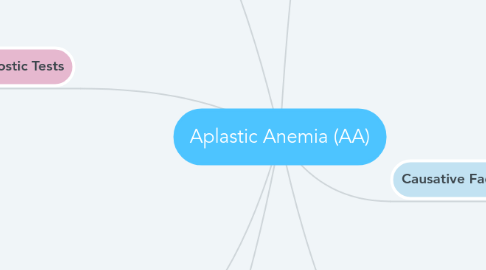Aplastic Anemia (AA)
by Timothy Walkowiak

1. Risk Factors
1.1. Exposure to chemicals such as benzene and arsenic
1.2. Chemotherapy
1.3. no gender bias
1.4. Genetics
2. Diagnostic Tests
2.1. CBC and reticulocyte count
2.2. Presence of pancytopenia
2.3. bone marrow biopsy revealing a hypocellular marrow.
2.4. Presence of 2 or more of the following
2.4.1. Bone marrow cellularity < 30% Absolute neutrophil count < 500/μL Absolute reticulocyte count < 60,000/μL Platelet count < 20,000/μL
3. Common Findings
3.1. Petichiae and nose bleeds from thrombocytopenia.
3.2. prolonged infections and poor wound healing.
3.3. dyspnea
4. Pathophysiology and Infection
4.1. Dysfunction in hematopoietic stem cell decreases production in leukocytes. With less differentiation of particular white blood cells being produced the body is less effective in fighting off infection and at increased risk for progressive complications from infection.
5. Pathophysiologic Etiology
5.1. Disorder of the hematopoietic stem cell that results in a loss of blood cell precursors, hypoplasia or aplasia of bone marrow, and cytopenias in two or more cell lines (RBCs, WBCs, and/or platelets).
5.2. Hypocellular bone marrow becomes replaced with fat
5.3. Normocitic-Normochromic Anemia which means anemia is caused by deficient number of erythrocyte production.
6. Causative Factors
6.1. Most cases are linked to autoimmune disease that attacks the hematopoietec stem cells.
6.2. Genetic links to autoimmunity
6.3. Genetic variations in HLA's and tumor necrosis factor cytokines.
6.4. True cases of AA are idiopathic and account for 75% of cases.
6.5. Secondary AA can be caused by chemotherapy, ionizing radiation and various chemical agents.
7. Treatments
7.1. Hematopoietic stem cell transplantation
7.2. immunosuppression with equine antithymocyte globulin and cyclosporine



